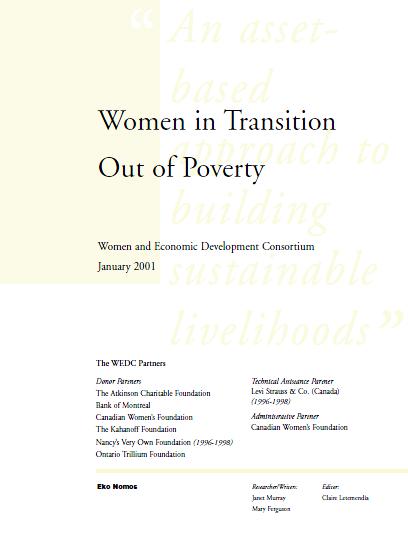This paper is about women and their transition out of poverty. It explores the process by which women use enterprise development as a vehicle to make changes in their lives, enhancing their independence and building a livelihood. It offers community economic development practitioners some practical learning and concepts that may assist in strengthening their economic development programs for women. It offers funders and policymakers a new asset-based framework to assist in the important work of supporting women to achieve self-sufficiency through enterprise development.
The paper has been grounded in case studies that describe women who have participated in Women and Economic Development Consortium (WEDC)-funded projects. The cases have allowed us to develop a picture of the women “before” and “after” their involvement in an economic-development project, exploring their transition over a two-to-four-year time line. We believe that the cases offer an accurate reflection of the range of low-income women’s experiences in Canada. As concrete examples, they provide us with clues to the broader experience of women in economic development. They also allow us to capture some of the general patterns that we’ve already seen in our work with women over the years.
Each of the women in the case studies came from very different life circumstances and dealt with her situation in a different way. None made her transition toward self-sufficiency alone. We must acknowledge that the WEDC projects are interventions designed to facilitate women’s involvement in the economy and, as such, played a role in supporting their participants’ transformations. We also recognize that not all of the women’s experiences in economic development programs were positive.
Yet we know that WEDC grantees’ asset-based service delivery and support interventions do support women to build their assets. There is great potential for the broad application of this approach in economic-development programs for low-income women across Canada. It is clear, however, that practical implementation of asset-based programs at the grassroots level can only be as effective as financial resources and a supportive policy context allow.
Download the PDF
Part One examines the idea of Sustainable Livelihoods from the perspective of low-income women. It introduces the concept of livelihood assets, explores the context that makes women vulnerable to poverty, identifies the strategies that women use to build assets, and sketches the general stages that women go through as they move towards a sustainable livelihood.
Part Two, Women in Transition Out of Poverty: A Guide to Effective Practice in Promoting Sustainable Livelihoods through Enterprise Development is a companion to the original piece and completes the narrative overview of the Sustainable Livelihoods framework. It investigates the connections between women’s stages of transformation and the design of economic development programs. Some practical strategies, techniques and tools are offered to support organizations in strengthening or implementing a Sustainable Livelihood approach in their work. It concludes with a discussion of the policy and funding implications of this approach





